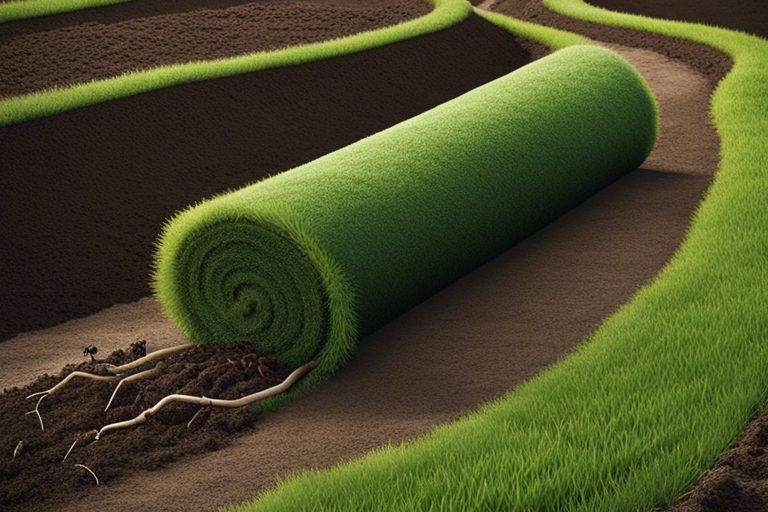Most land stewards underestimate the profound impact of grass in rolls on soil integrity and biodiversity. When you introduce these verdant mats into your environment, you are not merely beautifying your landscape; you are fostering a resilient habitat that promotes healthy ecosystems. The compact root systems of rolled grass hold soil together, preventing erosion while enhancing its structure, which in turn provides vital nutrients and moisture retention. As you probe into this exploration, you will discover how your choice can nurture the delicate balance of nature around you.
Key Takeaways:
- Soil Protection: Grass in rolls provides a protective layer that helps prevent soil erosion, thereby maintaining the structure and integrity of the soil ecosystem.
- Biodiversity Enhancement: The introduction of rolled grass promotes a diverse range of plant and animal species by creating a more suitable habitat for various organisms.
- Water Retention: Grass roots help improve soil moisture retention, which not only supports plant growth but also aids in sustaining local wildlife and ecosystems.

Soil Structure and Erosion
For many, the health of the soil is a silent but important concern, nestled beneath our feet. The delicate balance of soil structure plays a critical role in sustaining plant growth, regulating water, and maintaining biodiversity. As a robust tapestry of organic material and minerals, the unique arrangement of soil particles—referred to as soil aggregation—can significantly influence the soil’s resilience against erosion. Understanding how grass in rolls can enhance this aggregation is vital in preserving not only the land but also the ecosystems it supports.
The Importance of Soil Aggregation
To appreciate the power of soil aggregation, consider it as the foundation upon which your ecosystem stands. When soil particles clump together, they form larger aggregates that improve porosity, allow for better water infiltration, and create a habitat for diverse soil organisms. Without this structure, soils become prone to erosion, which can result in lost nutrients and reduced agricultural productivity. This condition, in turn, diminishes not only the **quality of your land** but the **biodiversity** it harbors, leaving both the flora and fauna without their important sustenance.
How Grass Rolls Prevent Soil Compaction
Importance of preventing soil compaction cannot be overstated; compacted soil restricts root growth, diminishes water infiltration, and can create a barrier for the movement of air and microorganisms. Grass rolls are instrumental in combating these dangers, as their deep-root systems help to bolster soil structure, allowing for spaces between particles that promote air circulation and moisture retention. As you lay down grass rolls, you invite a natural army of roots to intertwine, reinforcing the soil and mitigating the effects of external pressures from foot traffic, heavy machinery, and natural forces.
Soil health is a radiant entity that thrives on careful management and protection. When you install grass rolls, you’re fostering a network of **strong, interconnected roots** that function synergistically to combat the perils of soil compaction. These living systems are champions of soil integrity, contributing to a flourishing ecosystem that not only supports plant life but also nurtures the myriad critters beneath the surface. By understanding and implementing grass in rolls, you elevate not just your landscape but the very soul of your land.
Soil Organic Matter and Nutrient Cycling
Some may overlook the intricate relationship between soil organic matter and the abundant life that flourishes beneath our feet. When you consider grass in rolls, envision how these living entities root deeply into the ground, intertwining with soil particles to create a rich tapestry of organic matter. This organic matter acts as a sponge, improving soil structure and enhancing its ability to retain water and nutrients, thereby fostering a sanctuary for diverse organisms. As you engage in sustainable practices, remember that your soil is a living entity, and nurturing it promotes a vibrant ecosystem.
The Role of Grass Roots in Soil Carbon Sequestration
Matter beneath your garden’s surface plays a pivotal role in combating climate change and enhancing biodiversity. The roots of grass in rolls serve as vital conduits for carbon sequestration, drawing down carbon dioxide from the atmosphere and storing it in the soil. This process not only mitigates greenhouse gas emissions but also enriches the soil, forming a resilient and fertile ground for future plant life. As you allow these grasses to flourish, you actively contribute to a greater ecological balance.
Enhanced Nutrient Availability through Grass Roll Decomposition
Any gardener understands the importance of nutrients in cultivating flourishing plants. When grass in rolls decompose, they release a plethora of vital nutrients back into the soil, enhancing its overall quality and fertility. The slow breakdown of the grass provides a steady supply of nitrogen, phosphorus, and potassium—vital for the growth of your crops and the well-being of the soil microbiome.
Enhanced decomposition leads to improved nutrient cycling, ensuring your soil is consistently replenished with the elements it needs for robust growth. This natural process minimizes the need for synthetic fertilizers, reducing potential chemical runoff that can damage local waterways. By fostering healthy grass growth and allowing natural decomposition, you create a symbiotic relationship that not only boosts productivity but also nurtures the biological community within your soil, ultimately supporting a sustainable ecosystem.
Soil Biodiversity and Microbial Communities
Unlike the barren stretches of lifeless earth, the introduction of grass rolls into your landscape is not merely an aesthetic choice; it fosters a complex web of life beneath the surface. These vibrant tufts of greenery provide more than just visual appeal; they serve as a cradle for diverse microbial communities, nurturing the vital interactions necessary for soil health. When you embrace grass in rolls, you are taking a step toward enhancing the integrity of your soil ecosystem, producing a thriving sanctuary for life that often goes unseen.
Increased Microbial Activity in Grass Roll Soils
Biodiversity is the golden thread that weaves the intricate tapestry of health within your soil. The presence of grass rolls leads to an increase in microbial populations, as these green carpets exude organic compounds that act as food for unseen microbes. As the grasses establish themselves, they contribute to the development of nutrient-rich organic matter, which in turn supports an ever-expanding community of bacteria, fungi, and other microorganisms, further enriching the soil. This heightened activity helps to decompose organic materials more efficiently, converting them into forms that plants can easily absorb, thereby enhancing their growth and vigor.
The benefits of increased microbial activity extend beyond mere plant nutrition. These microorganisms participate in critical processes such as nutrient cycling and organic matter decomposition, enriching your soil with vital nutrients like nitrogen and phosphorus. Your grass roll environments not only bolster plant health but also create a long-term resiliency in your soil system, which can withstand environmental stresses and support a flourishing ecosystem.
Diverse Soil Fauna Supported by Grass Roll Ecosystems
Grass roots are more than just anchors; they provide a habitat for a diverse range of soil fauna. Grass rolls nurture an ecosystem where organisms such as worms, beetles, and various arthropods thrive, contributing to the overall biodiversity of your soil. The presence of diverse soil fauna is vital for soil aeration, which helps improve drainage and root penetration while enhancing the physical structure of your soil. Each organism plays a particular role, from breaking down organic matter to recycling nutrients, thereby creating a harmonious network that elevates soil vitality.
Soil beneath grass rolls serves as an inviting frontier, rich with the promise of thriving life. The diverse soil fauna stimulated by this unique ecosystem not only aids in the balance of your soil health but also acts as a natural deterrent against pests and diseases, minimizing the need for chemical interventions in your garden or landscape. By nurturing such habitats, you become an integral part of the ecological stewardship that echoes the ethos promoted by Aldo Leopold, ensuring that future generations may also experience the rich tapestry of life that thrives beneath our feet.
Water Infiltration and Retention
To understand the vital role of grass in rolls, you must first explore how it enhances water infiltration and retention in the soil. Grass rolls, with their root systems intertwined, create a network within the soil profile that promotes improved water penetration. As rainwater or irrigation seeps into the ground, the porous structure formed by the grass roots allows water to move through the soil more effectively. This leads to a healthier ecosystem where your vegetation receives the moisture it requires, ultimately resulting in lush, thriving plants.
Improved Water Penetration through Grass Roll Porosity
Through the natural porosity of these grass rolls, the soil experiences a beneficial transformation. As roots spread out and decay, they create spaces that trap water, allowing it to percolate deeply rather than run off into streams or gutters. This process ensures that adequate moisture is available to plants during drier periods. Consequently, you create a sustainable environment where water is not merely a fleeting visitor but becomes reliably integrated into the soil’s capacity.
Reduced Runoff and Increased Water Storage Capacity
With the integration of grass rolls into your landscape, you effectively reduce water runoff during heavy rains. The stable matrix created by the grass absorbs excessive moisture, thereby minimizing erosion and sediment transport. Additionally, this natural buffering helps mitigate flooding risk, safeguarding not only your property but also the surrounding ecosystem.
Improved water management via grass rolls leads to increased water storage capacity in the soil, ensuring that precious rainwater is retained rather than lost. This is especially crucial in arid regions or during prolonged dry spells where every drop counts. By encouraging deeper infiltration and reducing the volume of water that merely glides across the surface, you are fortifying your landscape against the challenges of climate variability, enhancing not just your garden, but also the integrity of the larger watershed.
Soil Aeration and Oxygen Availability
Now, when you consider the health of your soil, aeration and oxygen availability play crucial roles. Grass rolls, with their gradual decomposition, contribute significantly to these factors. Proper soil aeration not only encourages root growth but also aids in the overall vitality of the ecosystem beneath your feet. As you witness the transformation of these grass rolls into organic matter, you enrich the living tapestry of soil creatures working tirelessly to maintain balance and harmony.
Enhanced Soil Aeration through Grass Roll Decomposition
Decomposition of grass rolls introduces a variety of textures and pore spaces within the soil. As these grass layers break down, they create channels and voids, allowing air to permeate the soil more effectively. This process boosts soil structure, enhancing its ability to retain crucial nutrients and moisture. The enhanced *aeration* promotes deeper rooting for plants, which ultimately translates to healthier and more resilient ecosystems.
Moreover, the decay process fosters a diverse array of life, as microbes and earthworms thrive in the newly rich habitat. Their movements and metabolic activities further improve soil aeration, creating a synergistic cycle where each element supports the other. By investing in grass rolls, you’re not just paving the way for lush vegetation but also fortifying the *crucial framework* of your local ecosystem.
Increased Oxygen Availability for Soil Microorganisms
Through decomposition, grass rolls also enhance the availability of oxygen to the soil’s microorganisms. These tiny organisms are vital to nutrient cycling and soil fertility. When grass rolls break down, they release crucial gases into the soil, promoting a conducive environment for microbial activity. An *aerobic* atmosphere supports the growth of beneficial bacteria and fungi, which are crucial for breaking down organic matter and releasing nutrients back into the soil. Such processes cater to the needs of your garden, ensuring that plants receive the nutrients they require to flourish.
It is important to recognize that the presence of adequate oxygen not only nourishes these microorganisms but also suppresses the growth of harmful pathogens. In a healthy soil ecosystem, the balance of life thrives on the interplay of these subtleties. As you embrace the use of grass rolls, you are enhancing *the very essence of soil health*, creating thriving conditions that support both plant life and the invaluable microorganisms beneath the surface. In this delicate dance, every action you take contributes to the revival of the natural world, allowing it to flourish in harmony for generations to come.
Ecological Connectivity and Habitat Creation
Not only do grass rolls provide an aesthetically pleasing landscape, but they also play a crucial role in enhancing ecological connectivity and creating habitats that benefit a myriad of soil-dwelling organisms. As you embrace the idea of incorporating grass in rolls into your home’s landscape, you contribute to the weaving of a resilient ecological tapestry. By doing so, you directly aid in sustaining local biodiversity, offering avenues for various creatures to thrive. If you’re intrigued by how natural landscapes can reshape your living space while promoting sustainability, consider exploring Biodiverse Lawns: 8 Reasons to Embrace a More Natural ….
Grass Rolls as Corridors for Soil-Dwelling Organisms
On a fundamental level, grass rolls serve as vital corridors connecting fragmented habitats, allowing soil-dwelling organisms to traverse through your landscape with ease. These natural pathways promote genetic diversity by facilitating the movement of various species, from earthworms to fungi, which in turn enhances the soil food web—an vital component for maintaining healthy ecosystems. The continuity provided by grass rolls can help mitigate the risks associated with habitat isolation, particularly as urban development encroaches on natural areas.
Enhanced Biodiversity through Habitat Creation and Fragmentation
Creation of green spaces through the strategic implementation of grass rolls not only nourishes your immediate environment but also combats the perilous effects of habitat fragmentation. This approach elevates the standard of ecological health by fostering a multilayered habitat where diverse species can coexist, reproduce, and thrive. When you cultivate a lush expanse of grass through rolls, you unknowingly invite pollinators, birds, and beneficial microbes into your backyard, each contributing to the intricate balance that sustains local biodiversity.
Another significant aspect of **enhancing biodiversity through habitat creation** is the restoration of **microclimates** within your landscape. By embedding grass rolls into your environment, you create diverse niches that can support different life forms. These small patches serve as critical shelters in times of climate stress, providing refuge and sustenance to numerous organisms. Not only do you foster a vibrant ecosystem, but you also create a nurturing environment that reinforces the delicate threads of life interconnected in your very own backyard. By making these conscious choices, you become a steward of the land, ensuring that it thrives for generations to come.
Final Words
Summing up, as you explore the profound impact of grass in rolls on soil integrity and biodiversity, it’s clear that this natural solution is more than merely aesthetic. By incorporating these grasses into your landscape, you are not just contributing to the beauty of your surroundings but nurturing the very fabric of the ecosystem. As the roots of these grasses probe deep, they enhance soil structure, improving water retention and preventing erosion, ultimately supporting a diverse range of organisms that depend on a healthy environment. Your choices in land management can help sustain the intricate web of life that flourishes within soil ecosystems.
Moreover, as you foster biodiversity through the use of grass in rolls, you are championing the interconnectedness of all life. The lush green expanse that you cultivate not only provides habitat for myriad species but also serves as a vital resource for pollinators and other fauna imperative for maintaining ecological balance. It’s your active participation in this process that can turn your yard, or any open space, into a thriving sanctuary, echoing the wisdom of nature that Aldo Leopold espoused. In nurturing the earth through such practices, you become a steward of the land, ensuring that it remains vibrant for generations to come.
Q: How do grass rolls contribute to soil integrity?
A: Grass in rolls, also known as sod, enhances soil integrity by providing immediate ground cover that reduces erosion. The roots of established grasses create a network that holds soil particles together, thereby preventing runoff and soil degradation. This mat of grass also helps to absorb rainfall, allowing water to penetrate the soil more effectively and reducing surface compaction. As these roots develop, they improve the soil structure and aeration, facilitating better root growth for other plants and contributing to a healthier ecosystem.
Q: In what ways does rolled grass promote biodiversity in an area?
A: When rolled grass is introduced, it creates a habitat for various organisms, including insects, birds, and small mammals. The diverse plant life often supports different species, leading to a more stable and resilient ecosystem. Moreover, rolled grass can serve as a foundation for additional plant species to thrive and increase overall biodiversity. With the right type of grass chosen for the specific environment, it can attract pollinators and beneficial insects which further enhances the ecological balance.
Q: Are there specific types of grass that are better for soil integrity and biodiversity?
A: Yes, certain grass species are particularly effective for enhancing soil integrity and promoting biodiversity. Native grasses tend to thrive in their local environments and are adapted to the local climate and soil conditions, making them ideal for supporting local wildlife. Grasses like fescue and ryegrass are known for their deep root systems, which improve soil structure and health. Additionally, mixing various grass types along with wildflowers can create a more diverse ecosystem, fostering both soil stability and an array of wildlife interactions. Always consult with local agricultural or ecological experts to identify the best options for specific regions.



